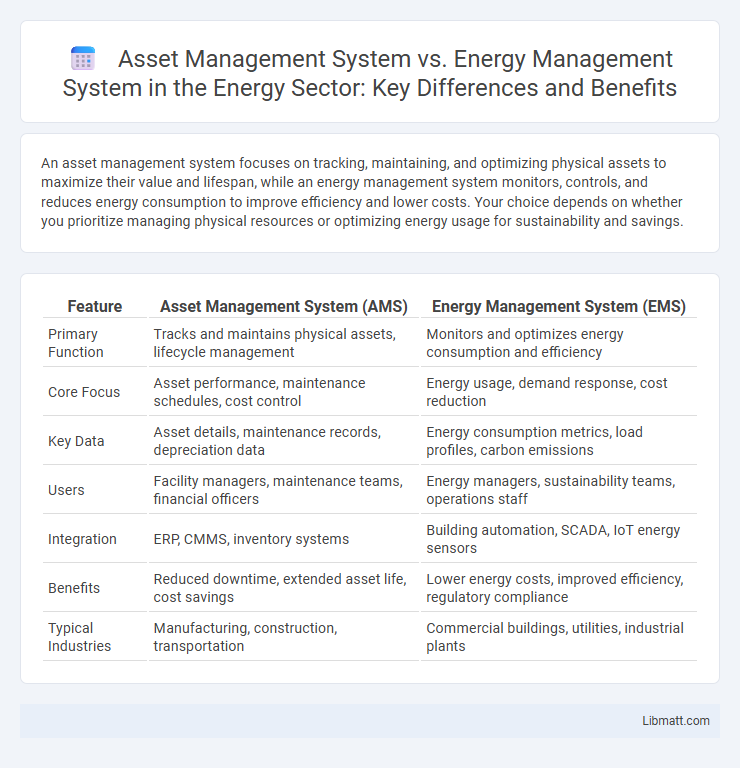An asset management system focuses on tracking, maintaining, and optimizing physical assets to maximize their value and lifespan, while an energy management system monitors, controls, and reduces energy consumption to improve efficiency and lower costs. Your choice depends on whether you prioritize managing physical resources or optimizing energy usage for sustainability and savings.
Table of Comparison
| Feature | Asset Management System (AMS) | Energy Management System (EMS) |
|---|---|---|
| Primary Function | Tracks and maintains physical assets, lifecycle management | Monitors and optimizes energy consumption and efficiency |
| Core Focus | Asset performance, maintenance schedules, cost control | Energy usage, demand response, cost reduction |
| Key Data | Asset details, maintenance records, depreciation data | Energy consumption metrics, load profiles, carbon emissions |
| Users | Facility managers, maintenance teams, financial officers | Energy managers, sustainability teams, operations staff |
| Integration | ERP, CMMS, inventory systems | Building automation, SCADA, IoT energy sensors |
| Benefits | Reduced downtime, extended asset life, cost savings | Lower energy costs, improved efficiency, regulatory compliance |
| Typical Industries | Manufacturing, construction, transportation | Commercial buildings, utilities, industrial plants |
Introduction to Asset Management Systems
Asset management systems track and optimize the lifecycle of physical assets, ensuring peak performance, reduced downtime, and cost efficiency across industries. These systems use data analytics and real-time monitoring to support informed decision-making and maintenance scheduling. Your organization benefits from improved asset utilization and extended equipment lifespan by implementing a robust asset management system.
Overview of Energy Management Systems
Energy Management Systems (EMS) optimize the monitoring, control, and conservation of energy across industrial, commercial, and residential settings. These systems integrate real-time data analytics, automated controls, and energy consumption reporting to enhance efficiency and reduce operational costs. EMS platforms often feature demand response capabilities and predictive maintenance to ensure sustainable energy use and compliance with environmental standards.
Key Functions of Asset Management Systems
Asset management systems primarily focus on tracking the lifecycle of physical assets, optimizing their performance, and scheduling maintenance to reduce downtime and extend asset longevity. These systems collect data on asset conditions, usage rates, and failure trends to inform decision-making and improve return on investment. Your organization benefits from improved risk management and cost control by implementing advanced asset management functions.
Core Features of Energy Management Systems
Energy Management Systems (EMS) primarily focus on monitoring, controlling, and optimizing energy consumption through real-time data analytics, automated load management, and predictive maintenance algorithms. Core features include energy usage tracking, demand response capabilities, integration with renewable energy sources, and compliance reporting to reduce operational costs and carbon footprint. Unlike Asset Management Systems that concentrate on asset lifecycle and performance, EMS drive sustainability and efficiency by enabling dynamic energy optimization across facilities.
Comparative Benefits: Asset vs Energy Management
Asset management systems optimize the lifecycle and maintenance of physical assets, enhancing operational efficiency and reducing costly downtime, while energy management systems focus on monitoring and controlling energy consumption to boost sustainability and lower utility expenses. Your business benefits from asset management's ability to extend equipment lifespan and improve capital allocation, whereas energy management delivers precise energy usage insights to achieve regulatory compliance and carbon footprint reduction. Both systems integrate data analytics but serve distinct strategic goals: asset management drives tangible asset performance, and energy management advances environmental and cost-saving objectives.
Integration Possibilities Between AMS and EMS
Integration possibilities between Asset Management Systems (AMS) and Energy Management Systems (EMS) enhance operational efficiency by enabling real-time data sharing and predictive maintenance analytics. AMS provides critical insights into equipment health and lifecycle management, while EMS focuses on optimizing energy consumption and sustainability metrics. Combined, these systems facilitate unified dashboards, improve asset utilization, reduce energy costs, and support proactive decision-making through advanced IoT sensor integration and AI-driven analytics.
Implementation Challenges and Solutions
Implementing an Asset Management System (AMS) often faces challenges such as data integration complexity and real-time asset monitoring, while an Energy Management System (EnMS) struggles with accurate energy consumption tracking and regulatory compliance. Solutions for AMS include adopting IoT sensors and AI-driven analytics to enhance asset visibility, whereas EnMS benefits from advanced metering infrastructure and automated reporting tools to optimize energy use and meet standards. Your organization can overcome these hurdles by selecting scalable platforms that support interoperability and continuous data validation for both systems.
Industry Applications: Use Cases and Examples
Asset management systems are extensively used in manufacturing, transportation, and utilities to monitor equipment life cycles, optimize maintenance schedules, and reduce operational costs through predictive analytics. Energy management systems find critical applications in commercial buildings, industrial plants, and smart grids by optimizing energy consumption, enhancing energy efficiency, and integrating renewable energy sources. Both systems play pivotal roles in sectors like oil and gas, where asset integrity and energy efficiency directly impact safety and profitability.
Cost Implications and ROI Analysis
Asset management systems optimize maintenance schedules and extend equipment lifespan, reducing unexpected repair costs and capital expenditures, thereby improving ROI through enhanced asset utilization. Energy management systems focus on monitoring and controlling energy consumption, enabling significant cost savings on utility bills and contributing to sustainability goals, which can yield a high ROI by reducing operational expenses. Comparing both, asset management systems typically offer long-term financial benefits through asset preservation, while energy management systems provide more immediate and measurable cost reductions from energy efficiency improvements.
Future Trends in Asset and Energy Management Systems
Future trends in asset management systems emphasize integration with IoT and AI for predictive maintenance, enhancing equipment lifespan and operational efficiency. Energy management systems increasingly leverage real-time data analytics and renewable energy sources to optimize consumption and reduce carbon footprints. Your organization can benefit from hybrid solutions combining both systems to drive sustainability and cost savings.
Asset management system vs Energy management system Infographic

 libmatt.com
libmatt.com